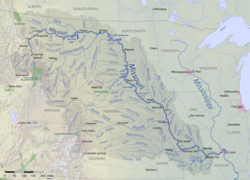

This is a list of dams in the watershed of the Missouri River , a tributary of the Mississippi River, in the United States. There are an estimated 17,200 dams and reservoirs in the basin, most of which are small, local irrigation structures. Reservoirs in the watershed total a capacity of approximately 141,000,000 acre-feet (174 km3). [1]
